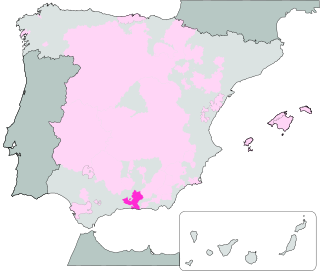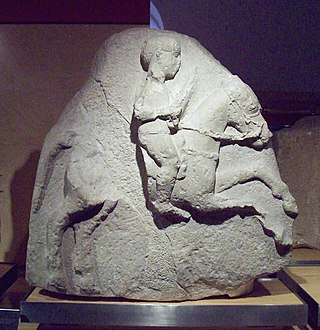
Andalusia is the southernmost autonomous community in Peninsular Spain. Andalusia is located in the south of the Iberian Peninsula, in southwestern Europe. It is the most populous and the second-largest autonomous community in the country. It is officially recognised as a historical nationality and a national reality. The territory is divided into eight provinces: Almería, Cádiz, Córdoba, Granada, Huelva, Jaén, Málaga, and Seville. Its capital city is Seville. The seat of the High Court of Justice of Andalusia is located in the city of Granada.
The Andalusian dialects of Spanish are spoken in Andalusia, Ceuta, Melilla, and Gibraltar. They include perhaps the most distinct of the southern variants of peninsular Spanish, differing in many respects from northern varieties in a number of phonological, morphological and lexical features. Many of these are innovations which, spreading from Andalusia, failed to reach the higher strata of Toledo and Madrid speech and become part of the Peninsular norm of standard Spanish. Andalusian Spanish has historically been stigmatized at a national level, though this appears to have changed in recent decades, and there is evidence that the speech of Seville or the norma sevillana enjoys high prestige within Western Andalusia.

Andalusian nationalism is the nationalism that asserts that Andalusians are a nation and promotes the cultural unity of Andalusians. In the past it was considered to be represented primarily by the Andalusian Party. However, the party disbanded in 2015; there are also lesser political organisations that identify with Andalusian nationalism. Some political forces without parliamentary presence like Nación Andaluza and Asamblea Nacional de Andalucía may be found advocating independence. There is also a movement defending the idea that Andalusian is not a dialect of Spanish, but a language of its own.

The current flag of Andalusia was adopted in 1918. Blas Infante (1885–1936), the "Father of the Andalusian Fatherland", initiated an assembly at Ronda in 1918. This assembly adopted a charter based on the Antequera Constitution and also adopted the current flag of Andalusia and emblem as "national symbols". Its name used to be Arbonaida or also Arbondaira.

The Regional Government of Andalusia is the government of the Autonomous Community of Andalusia. It consists of the Parliament, the President of the Regional Government and the Government Council. The 2011 budget was 31.7 billion euros. It employs about 500,000 workers.

The Emblem of Andalusia is the official symbol of Andalusia, an autonomous community of Spain. It bears the Pillars of Hercules, the ancient name given to the promontories that flank the entrance to the Strait of Gibraltar. Although often referred to as a coat of arms, it is technically an emblem as it was not designed to conform to traditional heraldic rules.

The Platform for Eastern Andalusia is a Spanish organization with regionalist character, set up juridically as an association, created from a civic initiative in the provinces of Jaén, Granada and Almería, with the objective of forming an autonomous community including these three provinces as Eastern Andalusia.

Laderas del Genil is a Spanish geographical indication for Vino de la Tierra wines located in the autonomous region of Andalusia. Vino de la Tierra is one step below the mainstream Denominación de Origen indication on the Spanish wine quality ladder.

The Statute of Autonomy of Andalusia is a law hierarchically located under the 1978 Constitution of Spain, and over any legislation passed by the Andalusian Autonomous Government. During the Spanish transition to democracy, Andalusia was the one region of Spain to take its path to autonomy under what was called the "vía rápida" allowed for by Article 151 of the 1978 Constitution. That article was set out for regions like Andalusia that had been prevented by the outbreak of the Spanish Civil War from adopting a statute of autonomy during the period of the Second Spanish Republic. Following this procedure, Andalusia was constituted as an autonomous community February 28, 1980. The regional holiday of the Andalusia Day commemorates that date. The statute was approved the following year by the Spanish national government.

The title of Hijo Predilecto de Andalucía or in the case of a female recipient Hija Predilecta de Andalucía is an honorific title granted annually on August 10 according to decree 156/1983 of the Andalusian Autonomous Government, recognizing exceptional merit or distinction in relation to the Andalusian region, through scientific, social or political actions or works that have redounded to the benefit of Andalusia. It is the highest distinction of the autonomous community of Andalusia.

The 2004 Andalusian regional election was held on Sunday, 14 March 2004, to elect the 7th Parliament of the autonomous community of Andalusia. All 109 seats in the Parliament were up for election. The election was held simultaneously with the 2004 Spanish general election.

The 2000 Andalusian regional election was held on Sunday, 12 March 2000, to elect the 6th Parliament of the autonomous community of Andalusia. All 109 seats in the Parliament were up for election. The election was held simultaneously with the 2000 Spanish general election.

The 1996 Andalusian regional election was held on Sunday, 3 March 1996, to elect the 5th Parliament of the autonomous community of Andalusia. All 109 seats in the Parliament were up for election. The election was held simultaneously with the 1996 Spanish general election.

The 1994 Andalusian regional election was held on Sunday, 12 June 1994, to elect the 4th Parliament of the autonomous community of Andalusia. All 109 seats in the Parliament were up for election. The election was held simultaneously with the 1994 European Parliament election.

The 1982 Andalusian regional election was held on Sunday, 23 May 1982, to elect the 1st Parliament of the autonomous community of Andalusia. All 109 seats in the Parliament were up for election.

The 2022 Andalusian regional election was held on Sunday, 19 June 2022, to elect the 12th Parliament of the autonomous community of Andalusia. All 109 seats in the Parliament were up for election.
A referendum on the initiative of the Andalusian autonomy process was held in Andalusia on Thursday, 28 February 1980. Voters were asked whether they ratified a proposed initiative for the provinces of Almería, Cádiz, Córdoba, Granada, Huelva, Jaén, Málaga and Seville to organize themselves into an autonomous community of Spain throughout the legal procedure outlined in Article 151 of the Spanish Constitution of 1978.

The second government of Juan Manuel Moreno was formed on 26 July 2022, following the latter's election as President of the Regional Government of Andalusia by the Parliament of Andalusia on 21 July and his swearing-in on 23 July, as a result of the People's Party (PP) emerging as the largest parliamentary force at the 2022 Andalusian regional election with an absolute majority of seats. It succeeded the first Moreno government and has been the incumbent Regional Government of Andalusia since 26 July 2022, a total of 620 days, or 1 year, 8 months and 11 days.

The geostrategic position of Andalusia at the southernmost tip of Europe, between Europe and Africa, between the Atlantic Ocean and the Mediterranean Sea, as well as its mineral and agricultural riches and its large surface area of 87 268 km², formed a combination of factors that made Andalusia a focus of attraction for other civilizations since the beginning of the Metal Age.
















